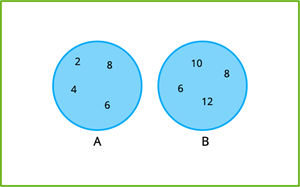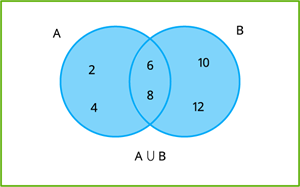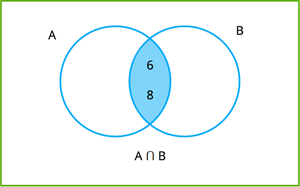
PUMPA - SMART LEARNING
எங்கள் ஆசிரியர்களுடன் 1-ஆன்-1 ஆலோசனை நேரத்தைப் பெறுங்கள். டாப்பர் ஆவதற்கு நாங்கள் பயிற்சி அளிப்போம்
Book Free DemoSet operation is an operation used to construct new sets from given sets.
There are several fundamental operations for constructing new sets from given sets. They are:
- Universal set.
- Union of two sets.
- Intersection of two sets.
- Difference of two sets.
- Symmetric difference of sets.
- Complement sets.
- Disjoint sets.
- Overlapping sets.
Universal set:
A universal set is the set of all elements under consideration, denoted by capital U. All other sets are subsets of the universal set.
In the Venn diagram below, represents a universal set.

Union of two sets:
Let A and B be any two sets. The union of A and B is the set consists of all elements of A and B; common elements being taken only once. The symbol ∪ is used to denote the union. Symbolically, we write A ∪ B and usually read as A union B.
Symbolically, we write A\cup B = \{x: x\in A\ \mathrm{or}\ x\in B\}
Let A=\{2,\ 4,\ 6,\ 8\} and B=\{6,\ 8,\ 10,\ 12\}.
Then, A\cup B=\{2,\ 4,\ 6,\ 8,\ 10,\ 12\}
Note: Common elements 6 and 8 have been taken only once while writing A ∪ B.
In the Venn diagram below A and B are represented.

In the Venn diagram below, the area in the blue colour represents A ∪ B.

Intersection of two sets:
The intersection of sets A and B is the set of elements which are common in A and B. The symbol ∩ is used to denote intersection.
Symbolically, we write A\cap B=\{x:x\in A\ \mathrm{and}\ x\in B\}.
Numerical: Let A=\{2,\ 4,\ 6,\ 8\} and B=\{6,\ 8,\ 10,\ 12\}.
Then, A\cap B=\{6,\ 8\}.
In the Venn diagram below A and B are represented.

In the Venn diagram below, the area in the blue colour represents A ∩ B.

Important!
The relation "is an element of", also called set membership, is denoted by the symbol "∈", and the relation "is not an element of", is denoted by the symbol "∉".